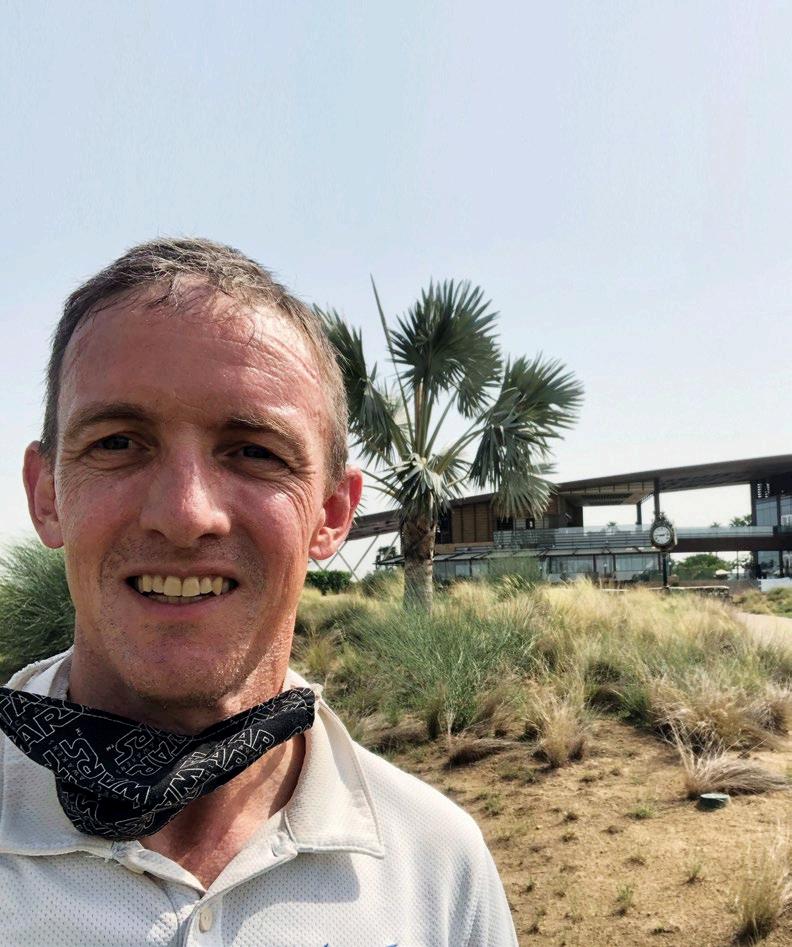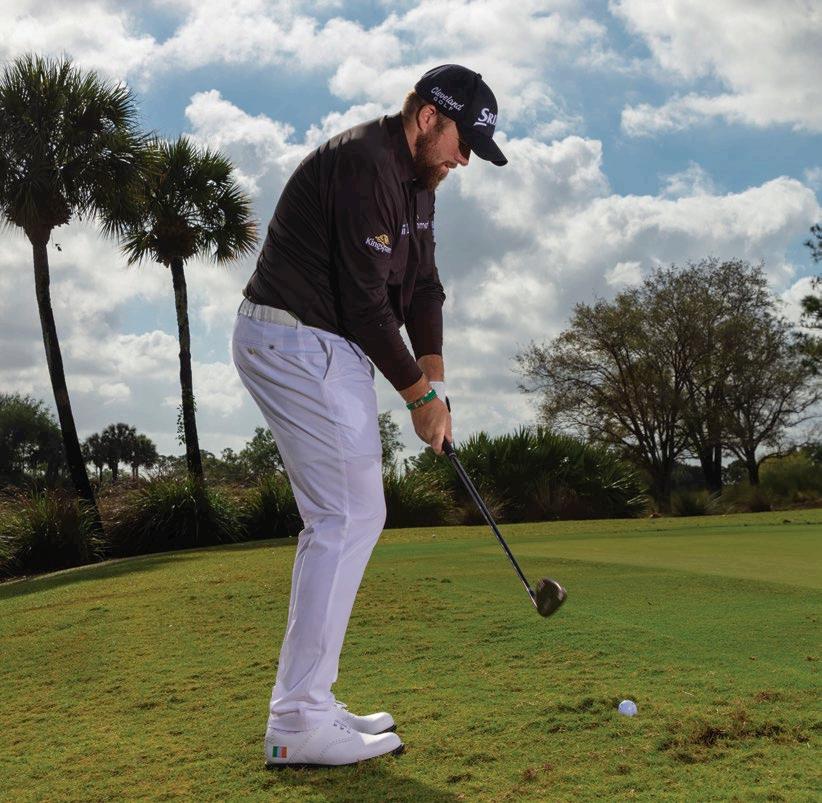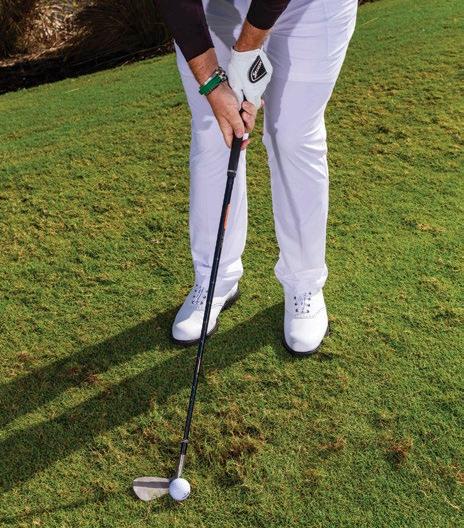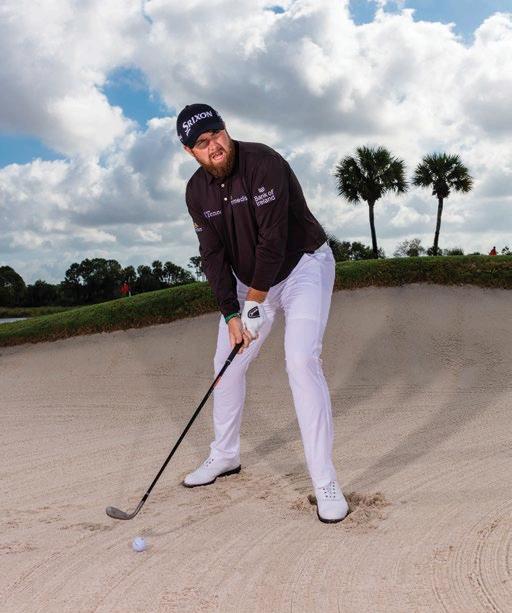
10 minute read
Golfers We Like
For Dad
One mid-summer round is more than enough for most Middle East amateurs. Unfazed, a Trump Dubai member just played four in a day.
“D ad introduced me to golf when I was eight and whenever I’m on a course, I am reminded of him.” ▶ Richard Charlesworth had more time than usual to remember his father last month when he endured temperatures in the high 30s and strength-sapping humidity to complete 72-holes in a day at Trump International Golf Club, Dubai.
The 49-year-old, Dubai-based Englishman was participating in the Macmillan Cancer Research Longest Day Challenge in honour of Thomas Charlesworth who lost his battle with the disease in 2017.
“I’ve known about it for a few years and wanted to do it. However, in the UK it’s light from 4.30am to 9.30pm in summer so you have enough time to walk four rounds as a four-ball. Here it had to be carts as it was over 30 even in the morning and high 30s during the day, with humidity that’s mid-40s, and not enough time to walk all four rounds.
“I was very lucky that there was a breeze and it wasn’t as humid as it had been two days previously when people were stopping after nine holes and I looked as though I had thrown myself into a swimming pool fully clothed. Besides changing clothes every round, I was very conscious to keep drinking water after every shot and put on the sun cream regularly. I also did some back, glute and hamstring stretching.”
Charlesworth set out on his charity adventure at 6.24am, Trump Dubai’s first tee time, and played the first 18 with friends from the British Dads’ Dubai Golf Society. Thereafter the Business Development Director for IHS Markit went it alone. As a former marathoner, Charlesworth unsurprisingly didn’t leave his prep to chance.
“Was it challenging? Yes. However, since gyms were closed in March I’ve been doing my own circuit-style sessions in my garden four to five times a week in the mornings. Over the last month, even the early mornings have been very hot and humid – over 30 degrees but feeling over 40. So I’ve got used to the heat somewhat.
“I also had four complete sets of spare clothes to change into, sports drinks, electrolyte tablets, Vaseline, sun cream, towels and a plastic bag to put all the sweaty clothes into. Thankfully there are water coolers every few holes and there’s a food/beverage cart on course.”
So how did the career-low 6.4 handicapper play, given the heat and the need to keep his pace up to ensure enough daylight?
“We played a four-ball better-ball match in the first round and then my scores were 82, 79 and 79. Oddly, I improved as I was trying to swing very easy to prevent injury, play easy recovery shots if necessary and, during the fourth round, I was starting to stiffen up.”
Impressively Charlesworth only missed four fairways in the final 54 holes although he would have liked more than his two-birdie return.
“The highlight was a birdie on 12th, a short par 4 which is drivable at 268 yards. Great drive, was only eight feet from the hole but missed the putt for eagle. I doubled the 3rd twice, a par 3, by pulling the ball into water. That lake has plenty of my balls from other rounds as well.
“I was playing carefree and just wanted to get round so wasn’t really thinking of the scores. There’s a lesson there that I should take into future rounds.”
Talking of future rounds, will you attempt 72-holes in a day again?
“I would like to do it walking at my home club, Upton-by-Chester. It’s the course where I learned to play and had so many rounds on with my Dad. Whenever I play there I can hear his voice telling me his golfing adages and where to aim.
“He was Club Captain in the early 90s so his picture is up in the clubhouse and I always go in to check it’s still there.” —kent gray
OLD SCHOOL SHORT GAME






SCHOOL SHORT GAMESCHOOL SHORT GAME by Shane Lowry W HEN I’M PLAYING IN a pro-am or an outing for a sponsor, I usually struggle to explain my short-game technique if I’m put on the spot. I stand there and have to think really hard about what I do. People say I’ve got all the shots around the green anyone could ever need, but I’ve been hitting them over and over since I was 10. The motions are second nature. But I still want to be helpful, so I’ve fi gured out two main things I can say about my chipping. ▶First, I’m trying to hole every chip shot. That might sound silly, but that’s the mind-set golfers should have when they walk up to their ball to take a look—even a beginner. It focuses your attention and gets you seeing the slopes and how the grass is growing all the way to the cup. You’ll be thinking about what you want the ball to do rather than the club. When you’re under pressure and thinking about the club, it rarely turns out well. At least that’s the way it is for me. ▶Second, I’m a big believer in doing things the way you’re most comfortable. I hit 99 percent of greenside shots with my lob wedge, which is a 58-degree with 6 degrees of bounce. Americans come over for the Open Championship and think they ought to start chipping with longer irons. But if a bump is a new shot to them, that isn’t the one they’ll see under the gun. I’ve heard countless pros claim their method for a shot is the best, but if I’ve learned anything in my career, it’s that there are a lot of ways to play this game. As long as your technique is halfway decent, you can play great. (Which is why I recommend taking one lesson from an instructor to get some fundamentals right. And sorry, I’m not your man for that.) ▶Try to hole the shot with the technique you fi nd most comfortable—that’s my whole chipping philosophy. Beyond that, I’ve got a few tips on some basic short-game shots—just little things I’ve learned that work for me. They might just help you, too. —WITH MAX ADLER

TOUGH LIES
Ilive in florida now, and it took me a while to get used to this Bermuda rough. It’s grainy, and even if it’s cut short, the ball can nestle low and be difficult to control. The mistake is to stand open and cut across it. An out-to-in swing path works great on rye or bentgrass, where you can slow down around impact and let the ball pop up. But do that in Bermuda, and the club sticks in the ground. You’ve got to keep your speed up with Bermuda. That’s why I like to set up square, or even a little closed, and feel my hands trying to hit a draw. You might not see a draw in the short flight of a chip, but the way the ball bounces and releases forward lets you know that you’ve done it right. If you need the ball to stop quickly after it lands, you can still think, draw. but purposefully hit it a tad heavy like a bunker shot. You’ll take a good divot, and the ball will come out softly and settle.
WITH BERMUDA ROUGH, YOU’VE GOT TO KEEP YOUR “ SPEED UP. SLOW DOWN, AND THE CLUB STICKS IN THE GROUND. SO TRY TO HIT A LITTLE DRAW.

HIGH AND SOFT
If you tend to butcher the delicate shots, mind your grip. My routine is two parts: First, I like to hold the grip in my right hand only and let the clubface fall open. For a full-on flopper, I’ll get the clubface looking directly at the sky like a spatula. For a mid-trajectory shot, something between a standard chip and a flop, I let the clubface fall open just a few degrees to add some loft. Second, I place my left hand on the grip. I want the back of it pointing to the target, so the most I see on that hand are two knuckles. This ensures a weak grip, which is key for soft shots. Finally, I make sure I’m not squeezing the handle tightly. We all tend to hold the club harder when we get nervous, which makes chips come out fast and hot.
PRACTICE
My coach, Neil Manchip, is also the coach for the boys and girls of the Golfing Union of Ireland. He has dozens of skills tests he gives these kids— games where you can’t advance until you hole a shot, or you’re forced to use a variety of clubs to hit the same shot, etc. Neil gives me the same tests, and we’ll have a bit of fun placing small wagers. I particularly like a game where I must hit nine chips from several spots before using up 30 feet. How it works is, if I hit the first chip to 10 feet from the cup, I have 20 feet remaining. But if I hit the next chip to a foot, I then have 19 feet remaining. We’ll do a mix of shots of reasonable difficulty. The best I’ve ever done is still having five feet left at the end. One of these days, I’ll do even better.
The takeaway is, variety is the key to practice. Even trying shots you’d never use in competition has tremendous value. You won’t see great short games from guys who just drop a bag of balls in one spot and hardly move.


BUNKER
In my opinion, Padraig Harrington is the best bunker player in the world. Three years ago, I was in a hotel and flicked on the tube, and there was Padraig doing an instruction program. He talked about keeping weight on his left side during the entire bunker shot, backswing and through-swing. I’d always favoured my right leg, hanging back perhaps to make sure the club entered the sand a couple inches behind the ball. The next morning, I tried Padraig’s way, and everything clicked. Instead of coming in shallow, I felt like I was coming more over the top to strike the sand. Ever since, I’ve been able to do whatever I want with bunker shots. Funny how life works out.
You’ll notice in these pictures that I stand square to the target line with my left foot flared. I think edging those front toes more toward the flag encourages the clubhead to release smoothly past the wrists through the sand. But that’s just me.

TRY TO HOLE BUNKER SHOTS, TOO. THERE’S NO HARM TO HOPE, “ UNLESS YOU’RE IN REAL TROUBLE. IT’S WHEN YOU THINK ABOUT ONLY GETTING IT CLOSE THAT YOU GET SLOPPY.

a quick word on plugged lies: My way is to close the face so it’s pointing a hair left of the target, then really chop down on it, feeling like I’m exploding the ball out with the heel of the club. Then, as you can see from my ball mark, I just hope for the luck of the Irish.











